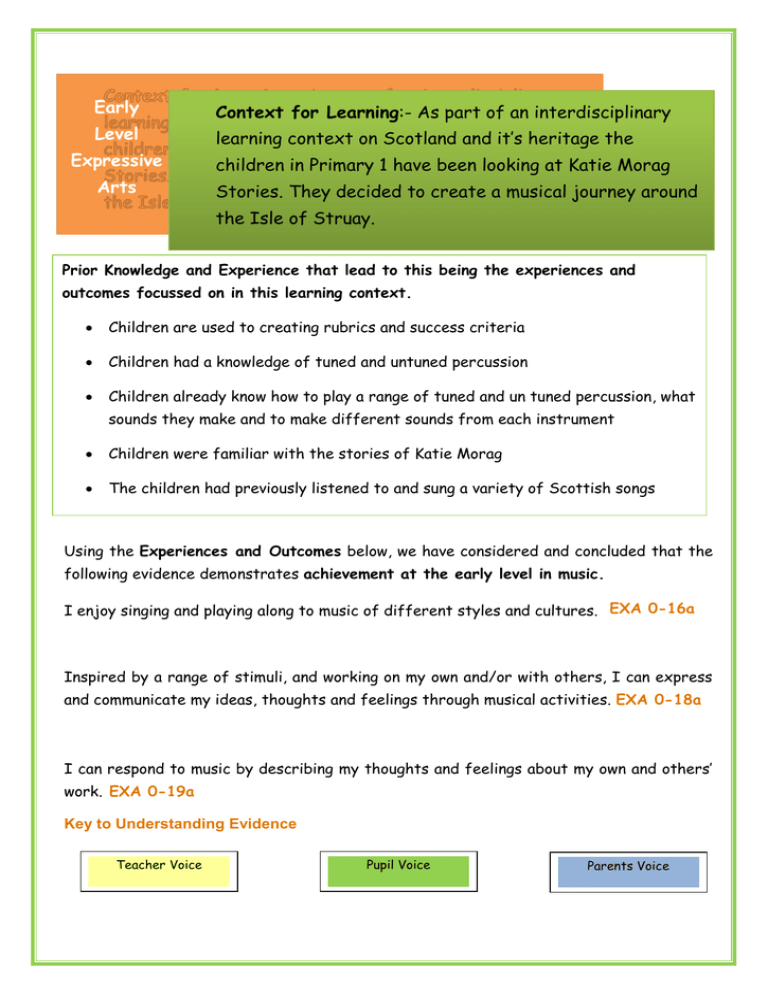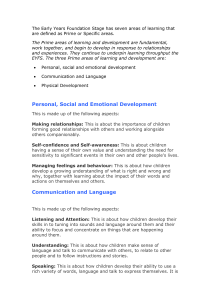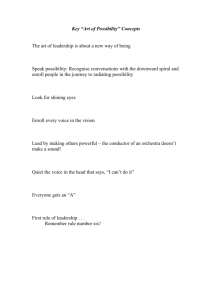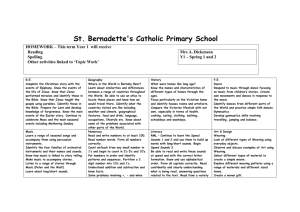Context for Learning learning context on Scotland and it’s heritage the Early
advertisement

Early Level Expressive Arts Context for Learning:- As part of an interdisciplinary learning context on Scotland and it’s heritage the children in Primary 1 have been looking at Katie Morag Stories. They decided to create a musical journey around the Isle of Struay. Prior Ea Knowledge and Experience that lead to this being the experiences and outcomes focussed on in this learning context. First Level are used to creating rubrics and success criteria Children Expressive Children had a knowledge of tuned and untuned percussion Children already know how to play a range of tuned and un tuned percussion, what Arts sounds they make and to make different sounds from each instrument Children were familiar with the stories of Katie Morag The children had previously listened to and sung a variety of Scottish songs Using the Experiences and Outcomes below, we have considered and concluded that the following evidence demonstrates achievement at the early level in music. I enjoy singing and playing along to music of different styles and cultures. EXA 0-16a Inspired by a range of stimuli, and working on my own and/or with others, I can express and communicate my ideas, thoughts and feelings through musical activities. EXA 0-18a I can respond to music by describing my thoughts and feelings about my own and others’ work. EXA 0-19a Key to Understanding Evidence Teacher Voice Pupil Voice Parents Voice Learning intentions Children should be able to Create different sounds, with varying volume by selecting the way they play given pitched and un-pitched instruments. Demonstrate an understanding of the role of a conductor in an orchestra while participating in a performance. Reflect on their own and their peers’ performances. The Success Criteria was created by the children and allowed them to reflect on their performance at each stage in the creation process in addition to commenting on their final performance. The children traffic lit their performance throughout the task, Red meaning they weren’t doing something, amber meaning that this was an area to develop. Green meaning that they were happy with this element of their creation /performance. Sound Map Success Criteria Learning Activity:- The children created their own sound map success criteria and used this to evaluate their own learning Evaluating creaCreatCreating Sound Map Success Criteria Some of the instruments were a little bit loud People were looking at the score to know when it was their turn When I was conducting some people weren’t looking so they didn’t know when it was their turn Significant Aspect of Learning:- Evidence of Learning in the Evaluating and Appreciating aspect of the Expressive Arts This exemplar shows that the child has had opportunities to The amber rating is reflected in the children’s comments where they identified what they managed to do, but that some people weren’t looking therefore couldn’t match their sound to the picture at the correct The children were able to talk about what a successful time It was in a good order, the order the were Children show an understanding ofpictures dynamics and in how made sense music this enhances Further Evaluation Activity Following the performance of our Primary 5/6 children of It’s a good song and went in the tune the new school anthem, the child was able to talk about what was good and what would make it better. The anthem would be even better if they were singing quietly and loudly The child demonstrates an awareness of the need for the words to match a rhythm and melody and hints how dynamics enhance a piece of music. Next Steps for the learning:- The children need to develop a wider knowledge of musical terminology to support their Childrenand show an understanding of dynamics and evaluations discussions. how this enhances music level music can talk about music they have listened to, their success criteria. They were able to talk about their final composition sounded. In particular in early sound map of the Isle of Struay should have, this became music and, on reflection traffic lit how they felt their analyse, explore and reflect including their own work, and the work of others. Learning Activity:- The children learned how to conduct an orchestra and use these skills to lead their class in a performance of a walk around the Isle of Struay When you are the conductor you have to move your hands up so the music has to get louder to get people to play. “It was difficult, to make thunder, because when we were meant to do child playing this instrument demonstrated an awareness and knowledge of The child demonstrated an awareness of sound and how to make the sound louder or softer the need to change the volume of sound did the pointing, they would point at you or your picture and tell you when to play. aspect of the Expressive Arts This exemplar shows that the child can perform and present for instruments were tinging really loudly. different audiences and be still” The child confidently conducts the part of an audience for others “orchestra” of Primary 1 and 2 children, in can demonstrate working front of an audience of children and parents, collaboratively as well as demonstrating all the characteristics learning independently identified by the children of a good conductor, including awareness of her orchestra (eg. eye contact and mouthing to them) and good timing, moving steadily through the piece. The child looks at the conductor and follows the score, clearly picking up the instrument (rain maker) at the correct time to start and stop playing. The child contributes to the composition alongside other peers. Watch video: Looking at the conductor The children had the opportunity to comment on the performance of other classes. This child recognises that volume of instruments impacts on how a piece of music experience enjoyment and contribute to other people’s enjoyment through creative and expressive performances and presentations In particular in early level music perform music from different styles and Next Steps for the learning:- Children to develop an awareness of dynamics, and the effects of louds and softs sounds. Learning in the Presenting loud bits and quiet bits some of the Watch video: Confident conductor The conductor was the person that Significant Aspect of Learning:- Evidence of The map was the music and I pointed around it with the baton The Presenting creaCreatCreating They were singing not too high, not too low, just the right volume which meant we all enjoyed it. cultures including singing/playing along with others, demonstrating awareness of sound and rhythm Learning Activity:- The children were asked to create a piece of music that told the story of a walk around the Isle of Struay First Level Expressive Arts We learned to play different types of instruments we listened Step 2 The child matched the Cabassa to the sound they thought would match the boggy Significant Aspect of Learning:- marsh, they could demonstrate how they would Evidence of Learning in the play this instrument in order to get “a Creating aspect of the Expressive squelching sound.” Arts to their sounds and put them to the right Step 1 The child was able to match appropriate instruments and their sound to locations on their 3D map of Struay things on the map. The person who writes the music is called the composer It would make a different tune if it was in a different order You put the picture on top of another one if you wanted two sounds together Step 3 Working together the children discussed their ideas about composing their music. The learner made suggestions and listened to her partner to create their own pictorial score. This shows that the learner has an understanding about how to layer sounds to build up volume and create an effect. Next Steps for the learning:- The children would develop a greater awareness of timing and sense of musical sound overlapping. Creating a greater flow to their composition Creating creaCreatCreating This exemplar demonstrates that the child can be creative and express themselves in different ways will be able to express themselves, think innovatively, meet challenges positively and find imaginative solutions to problems can work co-operatively and communicate with other, and in doing , show initiative, dependability , leadership and enterprise In particular in early level music Respond to stories, nursery rhymes and poems showing evidence of exploring sounds rhythms and using a range of pitched and unpitched instruments and technology





